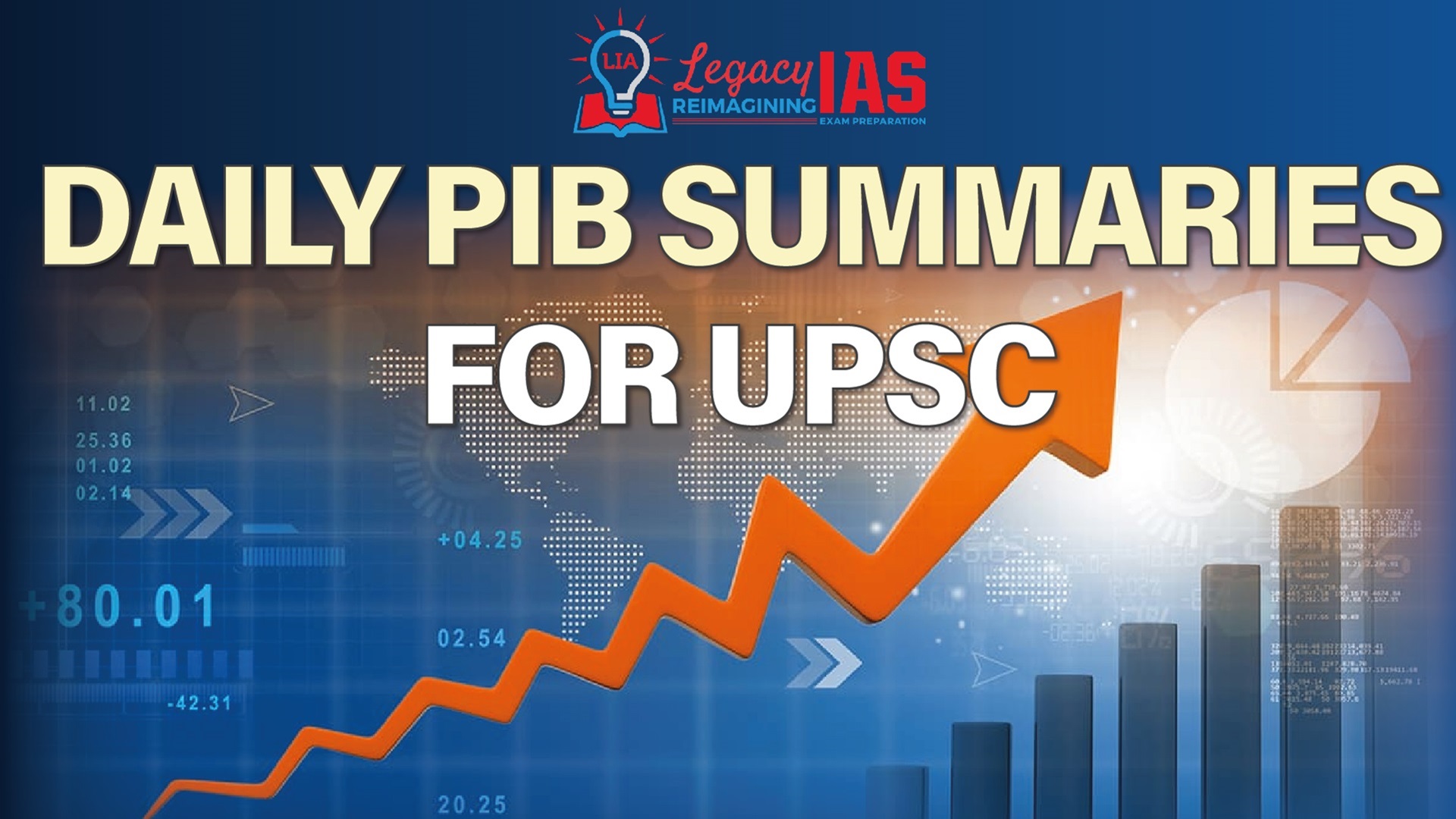
Content
- 67 and Rising: India’s Financial Inclusion Gains Momentum
- National Handloom Day 2025
67 and Rising: India’s Financial Inclusion Gains Momentum
What is Financial Inclusion?
- Definition: Financial inclusion refers to providing affordable financial services—banking, credit, insurance, pensions, and investments—to all individuals and businesses, especially underserved groups.
- Why It Matters: Enables inclusive economic growth, reduces poverty, increases resilience to financial shocks, and supports entrepreneurship and productivity.
- Global Recognition:
- UN SDGs: Identified as a key enabler in 7 out of 17 goals (e.g., poverty reduction, gender equality, decent work).
- World Bank: Monitors progress via Global Findex Database.
Relevance : GS 2 ( Governance, Inclusive Growth, Government Schemes), GS 3(Indian Economy)
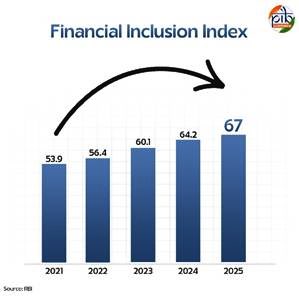
India’s Financial Inclusion Index (FI-Index) – Key Data (2025)
- FI-Index Value (2025): 67.0
- ↑ from 64.2 in 2024 and ↑ 24.3% since 2021 (baseline year).
- Index Scale: 0 (no inclusion) to 100 (complete inclusion).
- Index Components (97 indicators):
- Access (35% weight): Infrastructure availability – bank branches, ATMs, PoS, digital platforms.
- Usage (45% weight): Actual use of services – credit, savings, insurance, UPI.
- Quality (20% weight): Financial literacy, consumer protection, service equity.
PMJDY – The Foundation of Financial Inclusion
- Total Beneficiaries (Aug 2025): 55.98 crore
- Women Account Holders: >55% of total.
- Key Features:
- No minimum balance, ₹1 lakh accident cover, ₹10,000 overdraft, Rupay card.
- Outreach:
- 13.55 lakh Bank Mitras (banking correspondents).
- 107 Digital Banking Units (DBUs) functional (Dec 2024).
- Campaign Drive (July 2025):
- 6.65 lakh PMJDY accounts opened in 1 month.
- Over 10 lakh KYC updates.
- 99,753 outreach camps held.
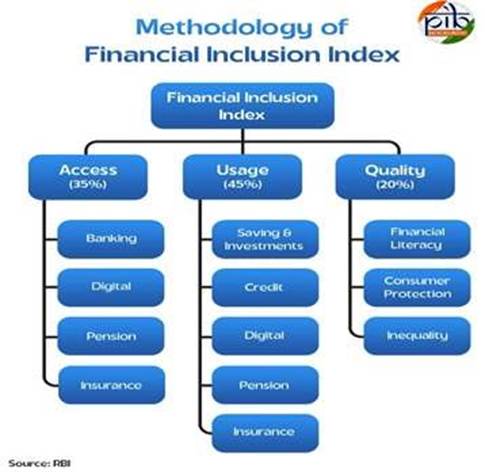
Key Support Schemes – Multi-Sectoral Expansion
a. Social Insurance Schemes
| Scheme | Coverage | Premium | Benefit |
| PMSBY | 50.54 crore (2025) | ₹20/year | ₹2 lakh (accidental death) |
| PMJJBY | 23 crore | ₹436/year | ₹2 lakh (natural death) |
b. Pension Scheme
- Atal Pension Yojana (APY):
- Subscribers: 7.65 crore (April 2025)
- Corpus: ₹45,974.67 crore
- Women subscribers: ~48%
- Monthly pension: ₹1,000–₹5,000 (based on contributions)
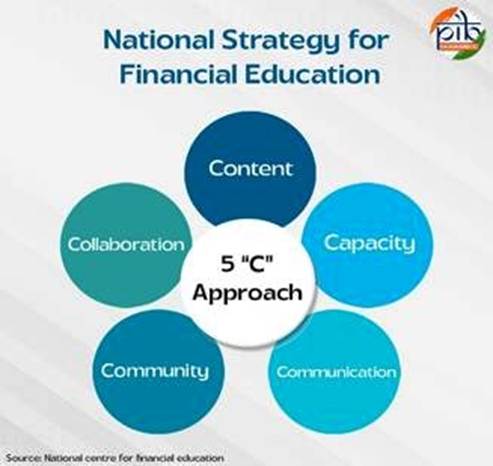
c. Credit Enablement – MSMEs & Women
- Pradhan Mantri MUDRA Yojana (PMMY):
- Loans sanctioned: 53.85 crore
- Amount sanctioned: ₹35.13 lakh crore (as on Aug 2025)
- Target groups: Women, minorities, first-time entrepreneurs
- New Initiative: Tarun Plus – ₹10L–₹20L loans for repeat borrowers
- Stand-Up India Scheme:
- Total amount sanctioned: ₹61,020.41 crore (as on Mar 2025)
- Focus: SC/ST/women entrepreneurs in greenfield ventures
d. Digital Empowerment – UPI Revolution
- UPI Transactions (June 2025):
- Volume: 18.39 billion
- Value: ₹24.03 lakh crore
- Share in India’s digital transactions: 85%
- Global Contribution: ~50% of world’s real-time payments
e. Women Empowerment – Mahila Sammriddhi Yojana
- Target: Economically weak women
- Loan: Up to ₹1.4 lakh to SHGs
- Disbursement: ₹72,859 lakhs (till Mar 2025)
f. Agriculture Credit – Kisan Credit Card (KCC)
- Operative accounts: 7.72 crore farmers
- Outstanding loan: ₹10.05 lakh crore (Dec 2024)
- ↑ from ₹4.26 lakh crore (2014)
- Purpose: Working capital, marketing, household needs, farm maintenance
Policy Frameworks – Strategic Anchors
a. National Strategy for Financial Inclusion (NSFI 2019–24)
- Objectives:
- Universal financial access within 5 km radius
- Basic financial bouquet: savings, credit, insurance, pension
- Livelihood & skill linkages
- Financial literacy through AV modules
- Grievance redressal and consumer protection
b. National Strategy for Financial Education (NSFE 2020–25)
- 5C Approach:
- Content: Curriculum & training material
- Capacity: Build intermediaries’ capabilities
- Community: Leverage local networks
- Communication: Mass outreach
- Collaboration: Multi-stakeholder effort
Recent Campaign – 2025 Financial Saturation Drive
- Timeline: July–September 2025
- Objective: Reach every Gram Panchayat/ULB to:
- Open new PMJDY accounts
- Enrol in PMSBY, PMJJBY, APY
- Conduct re-KYC
- Raise awareness on digital fraud, grievance redressal
- Progress (July 2025):
- 6.65 lakh accounts opened
- >10 lakh KYC re-verifications
- ~1 lakh outreach camps held
Outcomes and Impact – India’s Financial Inclusion Landscape (2025)
- FI-Index reflects:
- ↑ access and use of banking and digital services
- ↑ quality via financial literacy and protection
- Inclusivity gains:
- Women, rural households, small entrepreneurs, unorganised sector
- Reduced informal credit dependency, esp. in agriculture and MSMEs
- Massive digital transformation through UPI and DBT architecture
Challenges Ahead
- Sustainability of Usage: Moving from mere account ownership to active usage
- Digital Divide: Regional, gender-based, and rural-urban disparities
- Financial Literacy: Low awareness of rights, fraud risks, grievance redressal
- Cybersecurity: Rising frauds as digital penetration increases
Conclusion
- India’s rising Financial Inclusion Index (67 in 2025) reflects a robust shift from access to active usage and quality, driven by digital innovation (like UPI), targeted schemes (PMJDY, APY, MUDRA), and grassroots campaigns for saturation and literacy.
- The transformation is structural and inclusive—bridging rural-urban, gender, and class divides—laying the foundation for equitable, resilient, and participatory economic growth.
National Handloom Day 2025
Background & Significance
- Historical Roots:
- Tied to the Swadeshi Movement launched on 7th August 1905, promoting indigenous industries like handloom as tools of economic resistance.
- Institutionalisation:
- 7th August declared National Handloom Day in 2015, first celebrated in Chennai.
- Objective:
- Celebrate handloom heritage.
- Recognise contributions of artisans.
- Promote ‘Vocal for Local’ and Atmanirbhar Bharat.
Relevance : GS 1( History , Heritage)
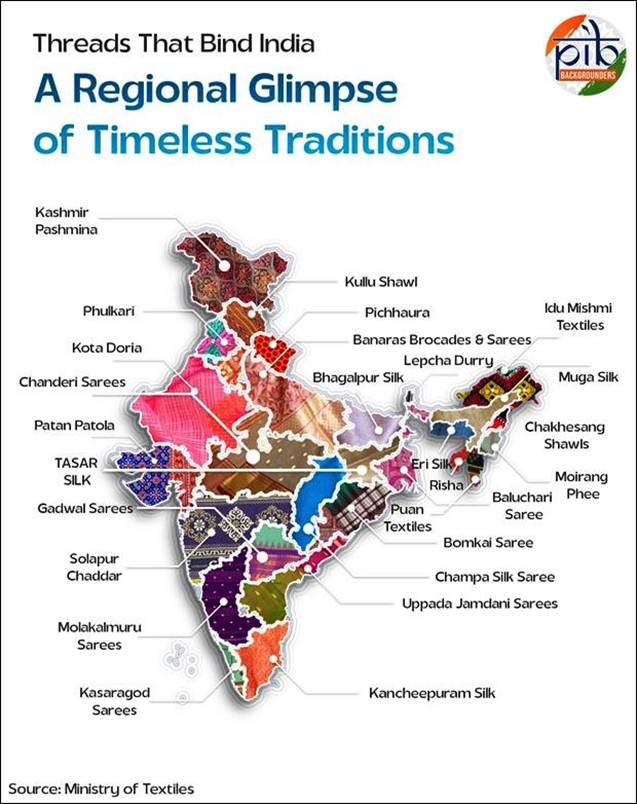
11th National Handloom Day 2025
A. Venue & Awards
- Date & Venue: 7th August 2025, Bharat Mandapam, New Delhi.
- Dignitary: President of India.
- Awards Distributed:
- Sant Kabir Awards (5):
- ₹3.5 lakh, gold coin, Tamrapatra, shawl, certificate.
- National Handloom Awards (19):
- ₹2 lakh, Tamrapatra, shawl, certificate.
- Sant Kabir Awards (5):
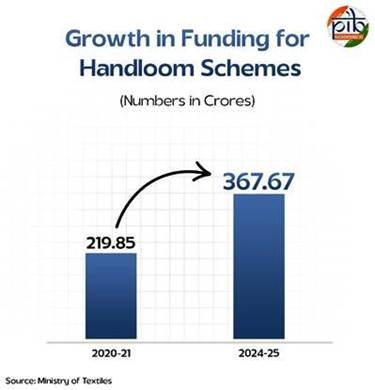
B. Theme-based Innovation:
Handloom Hackathon 2025
- Date: 4th August at IIT Delhi.
- Theme: “DREAM IT; DO IT”
- Stakeholders: Ministry of Textiles, NDC, FITT, IIT-D.
- Objective: Tech-enabled, design-led solutions for traditional problems.
C. Public Engagement Initiatives
1–8 August 2025: Week-long Celebration
- Know Your Weaves Campaign:
- Venue: National Crafts Museum, New Delhi.
- Activities:
- Live demos, storytelling, natural dye workshops.
- Weaves like Banarasi, Chanderi, Kanchipuram, Pochampally.
- Youth engagement through quizzes, installations.
- Saree Festival: Janpath Haat (116 weaves).
- Fashion Shows:
- Vastra Veda – regional handloom showcases.
- Naad – fusion of music and handloom narratives.
- India International Hand-woven Expo:
- Dates: 7–9 August at Bharat Mandapam.
- Buyers–Sellers meet for global promotion.
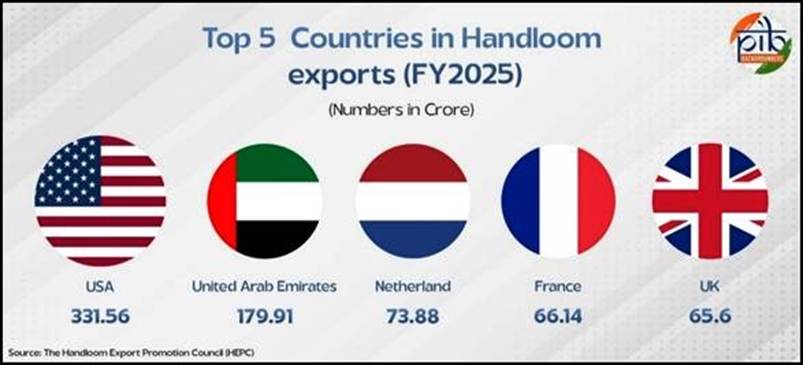
Sectoral Overview: Economic & Social Context
A. Employment & Livelihood
- Largest cottage industry in India.
- 4th Handloom Census (2019-20):
- 35.22 lakh households, >35 lakh artisans.
- Women comprise 72% of weavers – vital for rural women’s empowerment.
B. Cultural Relevance
- Carries stories of heritage, identity, and ecology.
- Made using eco-friendly, low-capital, and sustainable methods.
- Popular weaves: Banarasi, Kanjeevaram, Chanderi, Bomkai, Paithani, Jamdani, etc.
Global Recognition & Export Performance
A. India’s Global Handloom Standing
- 95% of the world’s handwoven fabric is from India.
- Unique due to living craft traditions + commercial viability.
B. Exports (FY 2024-25):
| Country | Export Value (₹ crore) |
| USA | ₹ 331.56 |
| UAE | ₹ 179.91 |
| Netherlands | ₹ 73.88 |
| France | ₹ 66.14 |
| United Kingdom | ₹ 65.6 |
C. Product Categories (Share in Total Export):
- Made-ups (Curtains, linen): 42.4%
- Floor coverings: 40.6%
- Clothing accessories: 12.7%
- Fabrics: 4.3%
Government Schemes: Financial & Policy Support
A. Key Schemes
| Scheme | Objective |
| NHDP | Cluster development, marketing, skill building |
| Raw Material Supply Scheme (RMSS) | Yarn subsidy, freight reimbursement |
| MUDRA Loans | 6% interest rate, margin money, online portal |
| Handloom Mark & India Handloom Brand | Certification & branding of authentic products |
| Small Cluster Development Programme | Up to ₹2 crore/cluster for tools, looms etc. |
B. NHDP Performance
| Parameter | 2014–24 | 2024–25 (so far) |
| Clusters Sanctioned | 715 | 79 |
| Funds Released (₹ crore) | 533.17 | 85.99 |
| Beneficiaries Covered | 2.16 lakh | 12,221 |
| Marketing Events | 2316 | 177 |
| Products under GI Act | 73 | 31 |
C. Social Security Measures
- PMJJBY, PMSBY, MGBBY schemes.
- Awardee weavers (60+ years): ₹8,000/month support.
- Children of weavers: Scholarships up to ₹2 lakh/year.
Modernisation, Digitisation & Capacity Building
| Initiative | Description |
| Skill Upgradation | Eco-dyeing, design innovation, e-commerce skills |
| Hathkargha Samvardhan Yojana | Govt bears 90% cost of new looms |
| Workshed Scheme | ₹1.2 lakh units; 100% subsidy for marginalised |
| Producer Companies | 163+ companies formed to improve market access |
| indiahandmade.com & GeM | 1.8 lakh onboarded on GeM; 2418 sellers on IndiaHandmade |
GI Tagging: Preserving Design Identity
- 104 handloom products registered under GI Act (1999).
- Seminars, workshops conducted for awareness and registration.
Critical Appraisal
Strengths:
- Deep cultural roots + global market edge.
- Inclusive (women-dominated, rural employment).
- Eco-friendly production.
- Supported by strong institutional frameworks (NHDP, RMSS).
Challenges:
- Competition from powerlooms & cheap imports.
- Lack of awareness among youth & modern consumers.
- Low income levels despite high skill.
- Fragmented supply chains, weak marketing.
Way Forward
- Design-Led Innovation: Expand hackathons, design schools in clusters.
- Market Expansion: Strengthen exports via trade pacts, fashion weeks.
- Digital Push: Strengthen platforms like indiahandmade.com.
- Social Media Campaigns: Influence-driven marketing to attract youth.
- Integrated Value Chains: Cooperatives, logistics, branding under one roof.
- Financial Literacy & Credit Access: Strengthen Mudra, SHG linkages.
- Education: Include handloom heritage in school & design curriculums.
Conclusion
National Handloom Day 2025 exemplifies India’s renewed commitment to blending heritage with innovation, honouring the artisans, and building a self-reliant handloom ecosystem. It reflects a strategic vision of “economic empowerment through cultural pride.” As India celebrates its weaving traditions, the focus is shifting from preservation to transformation, from craft to commerce.
